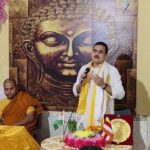GUIDED BY BHARATIYA INSPIRATION
- By : Anirban Ganguly
- Category : Articles
It would be interesting to avoid adding to the surfeit of reference to Machiavelli and to Sun Tzu, and peer instead into our Bharatiya texts whose articulations of civilisational goals of India’s polity and aims of its rulers retain a vibrant breath of life and contemporary energy
It would be interesting to avoid adding to the surfeit of reference to Machiavelli and to Sun Tzu, and peer instead into our Bharatiya texts whose articulations of the civilisational goals of India’s polity and the aims of its rulers still retain a vibrant breath of life and of contemporary energy. Ancient Bharatiya texts abound with ethical instructions and injunctions to the ruler — and in all of these, theleitmotif is the need for the ruler to be self-cultured, compassionate and benevolent with a capacity to absorb and be bound bydharma. A ruler firmly embodying these qualities can ensure the prosperity and happiness of his people. A number of these injunctions continue to have deep significance for our present.
In his Gleanings on Social Life from the Avadanas, legendary historian Nilakanta Sastri points to the text which describes land where adharmic king rules in the dharmic way: “…sphitam ca ksemam ca subhiksam ca akirnabahujana–manusyam ca prasanta-kali-kalaha-dimba-damaramtaskararogapagatam saliksu-go-mahisi-sampannam dharmiko dharmarajo dharmarajyam karayati.” (…The land described (above) is flourishing and prosperous, well-populated and perfectly peaceful; there are no quarrels among men, no thieves and no disease, there is an abundance of fine rice, sugar cane, cows and milch buffaloes; such a kingdom it is that a dharmic king rules in dharmic ways).
Sastri also discusses the usual argument against such texts and injunctions, “…texts like this are utopian in character”, he notes, “and it is easy to dismiss them as wild imaginings with no bearing on the realities of life. But a little reflection shows that in fact these apparently impossible ideals exerted a tangible influence on the conduct of all truly great rulers of India…The text cited above is the Indian way of exhorting kings to promote the economic welfare of their subjects and ensure harmony in society.”
In governance and settlement of disputes, the ideal “continued to be unanimity of consent; and it is only if that was unattainable, and necessity forced some kind of a practical decision that voting was resorted to.” There were also prescriptions for punishing the obstructionists, creators of disharmony in the carrying out administration, Sastri refers to an inscription of c800 CE recovered from a village in the southern Indian district of Tirunelveli which contains provisions for punishing the obstructionists who persisted in unreasonable opposition so as to make administration of the affairs of the village impossible.
Rectitude in character and conduct of the ruler and concern for the welfare of subjects was paramount in the consideration of ancient Indian political traditions. The standards were exacting and put the aspiring ruler under minute scrutiny and beholden to a strict code. Inscriptions discovered at Uthiramerur in Chingleput district of Tamil Nadu, for example, records the mode of election to the village Assembly under the Chola administration. Experts have termed the system described in the inscriptions as a Constitution that existed a 1,000 years ago.
The modes remain interesting even today — across the bridge of a millennia: First, a person, having been elected to one of the public committees did not render proper accounts at the end of a year was disqualified from standing for the election throughout his life. Second, any elected member who accepted bribe was also permanently debarred from standing for elections. Third, one who misappropriated any property was also disqualified. Fourth, one who acted against the interest of the society (here the village) and was a potential danger to the peaceful life of the people (graama kantaka) was also debarred from election.
The ruler too was exhorted to strict injunctions in discharge of his administrative responsibilities. Chandeshwara, in his celebrated 14th century treatise Rajanitiratnakara, cites the passage where it is said that “Visnu resides in subjects as in king” — ‘iti sarvam praja-visnum’ implying thereby that the king while protecting his subjects and attending to their welfare must look upon his subjects as the embodiment of divinity. The aura of divinity of the monarch was equally sought to be distributed to his subjects as well.
The king was expected to take an oath (pratijña) on his coronation (abhiseka) of upholding values and perpetuating righteous rule. If he failed to keep the pledge, he was stigmatised as an asatya-pratijña and was held to have automatically forfeited the throne. The king who did not keep his coronation-oath was known as ‘pratijña-durbala.’
TheMahabharata in the Rajadharmanusasana Parva talks of virtues recommended by therishis — ‘Tranquillity, self-restraint, fortitude, truth, purity, simplicity, sacrifices, perseverance, and righteousness.’ Protection to the weak and the practice of charity was an essential kingly duty, omitting these invited ‘sin’: ‘Those members of the kingly order that do not practise charity and give protection (to others), incur sin. Woe is their portion hereafter and not bliss.’
The highest duties of kings were seen as ‘restraining the wicked, cherishing the honest, and never retreating from battle’; the king had to govern by performing to perfection his key duty which was: Protecting his subjects righteously. The ruler’s ethical edicts called upon him to show restraint, impartiality and by living frugally directed him to encourage the righteous and to tread the path of virtues.
For those rulers who practised ‘charity and ascetic penances,’ who were ‘possessed of the quality of compassion and (were free) from desire and wrath, (and were) engaged in ruling their subjects with righteousness’ a high-attainment in the hereafter was assured. Similarly, the king who disregards lust and wrath, behaves impartially, like a father, towards all his subjects, never incurs sin or opprobrium.
In the governance ethics of theMahabharata: Renunciation, impartiality, promotion of righteousness — by the ruler stand out. The true administrator, the actual policymaker, the real ruler had to govern his conduct essentially within a wide ethical parameter. The symbols of a dharma inspired action had evolved to a great degree of perfection. In the end, as the Mahabharata put it simply, the best of kings is always one ‘whose conduct, even after his death, is applauded by the inhabitants of city and country and by his counsellors and friends.’
The Kamandakiya Nitisara, a leading one among the many Bharatiya seminal text on the ideals, objects and philosophy of Bharatiya polity, interestingly observes, that the essential requisites of ruler are the possession of three saktis — prabhusakti, ‘majesty or pre-eminent position of the king himself’; mantrasakti, ‘the power of good counsel’ and utsahasakti, ‘the power of energy.’
When one heard Prime Minister Narendra Modi addressing the nation — a State of the Union address — from the ramparts of the Red Fort on August 15, one discerned the manifestation of that righteous rule and the convergence and harmonisation of all three saktis, as enjoined by Kamandakiya and numerous other Bharatiya thinkers, who over the ages, dreamt of the advent of civilisational India.
Kamandakiya’s caution which, interestingly, retains a contemporary ring also comes to mind. A ‘dynasty’, he wrote ‘of which the princes are immodest, speedily meets with its fall.’ India has had enough of such an immodest dynasty; it now thrills to the call for righteous rule.

















